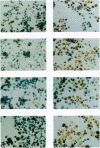Abstract
The WAF1/CIP1 protein has been identified as a downstream mediator of the tumor suppressor p53 in regulating cell cycle progression through a G1-phase check-point. Recent work has implicated the functional status of p53 as a critical determinant in the apoptotic response of certain cell lines to DNA damaging agents. By using human T-cell leukemia virus type I-transformed lymphoid cell lines that differ in their level and function of wild-type p53, we investigated the induction of WAF1/CIP1 and apoptosis after exposure to Adriamycin, a genotoxic agent. We found that regardless of the p53 status in these cell lines, WAF1/CIP1 RNA was rapidly induced in response to Adriamycin treatment. An elevated level of WAF1/CIP1 protein was observed as well. Additionally, we demonstrated that apoptosis was induced in all cell lines analyzed despite some having functionally inactive p53 protein. Our data suggest that a p53-independent pathway may play a role in the apoptotic response observed in some cell lines after exposure to DNA damaging agents.
Full text
PDF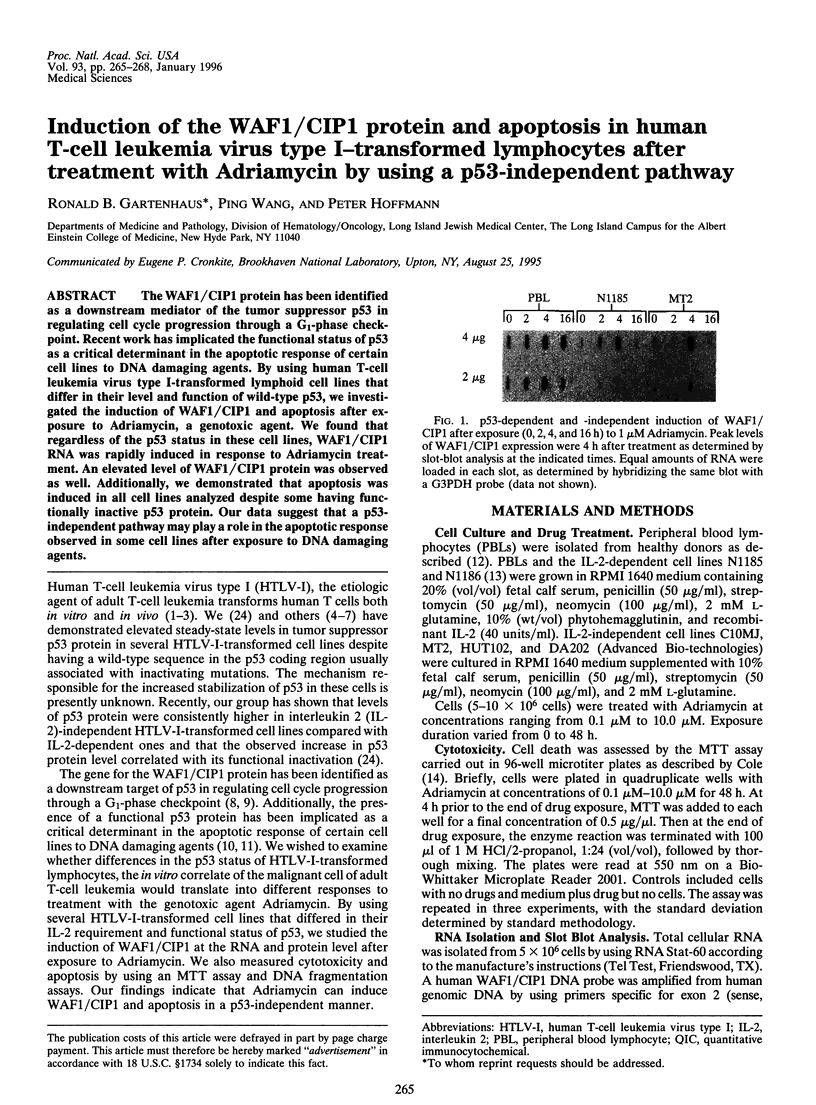
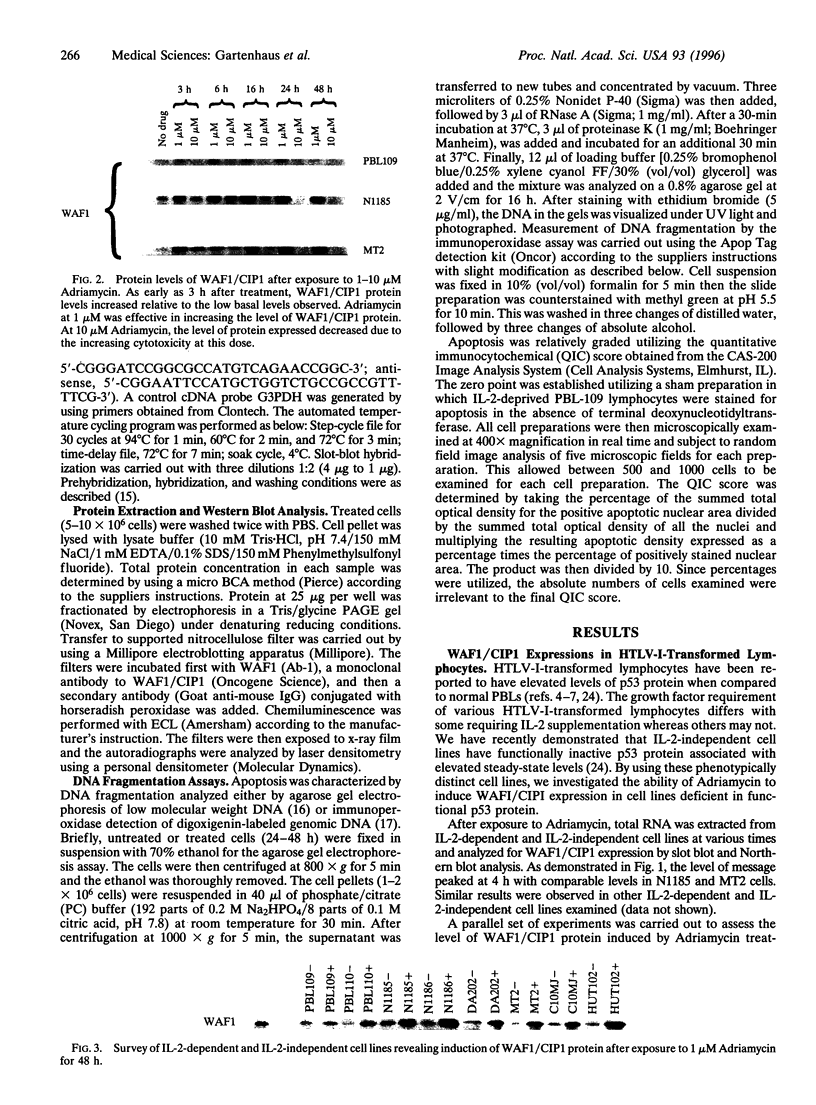
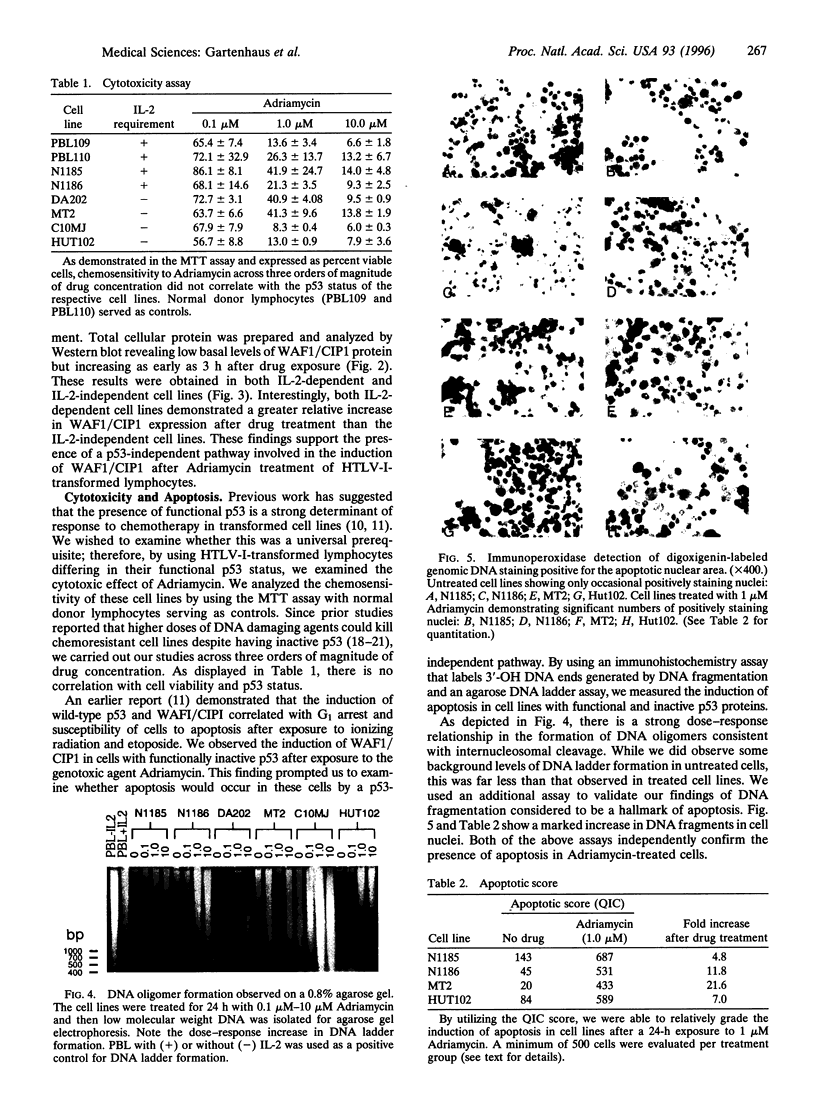
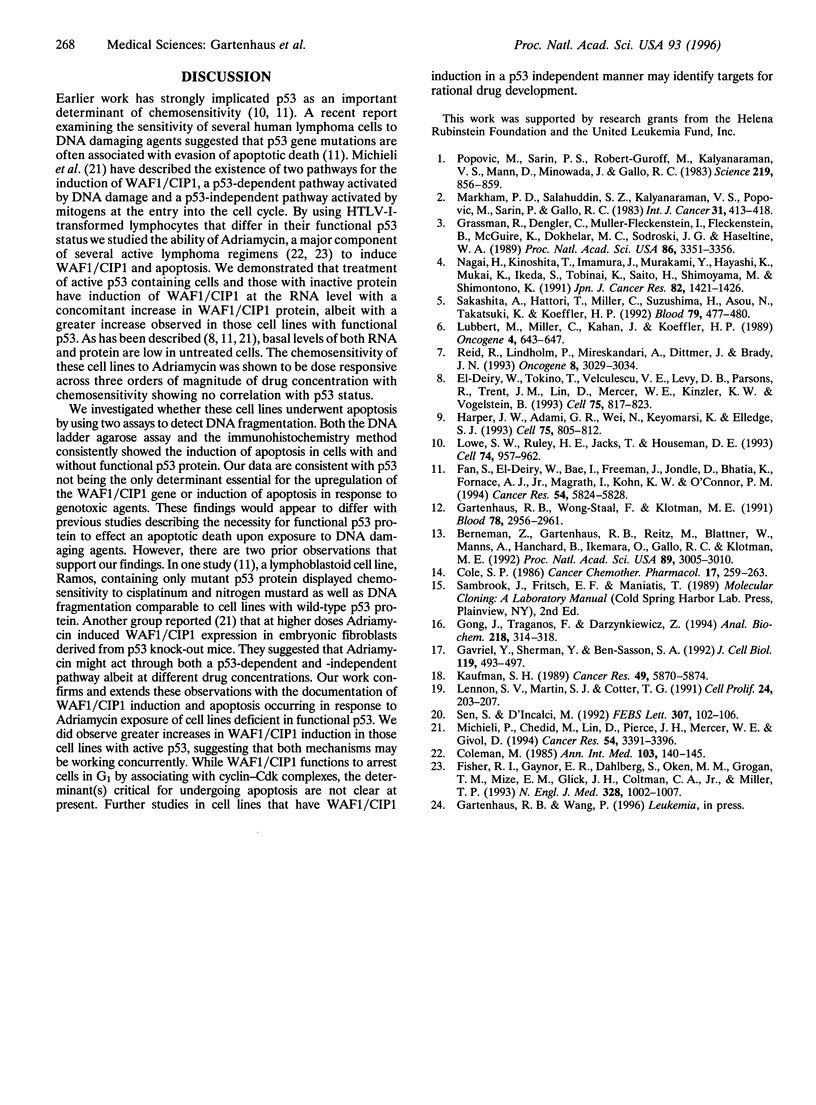
Images in this article
Selected References
These references are in PubMed. This may not be the complete list of references from this article.
- Berneman Z. N., Gartenhaus R. B., Reitz M. S., Jr, Blattner W. A., Manns A., Hanchard B., Ikehara O., Gallo R. C., Klotman M. E. Expression of alternatively spliced human T-lymphotropic virus type I pX mRNA in infected cell lines and in primary uncultured cells from patients with adult T-cell leukemia/lymphoma and healthy carriers. Proc Natl Acad Sci U S A. 1992 Apr 1;89(7):3005–3009. doi: 10.1073/pnas.89.7.3005. [DOI] [PMC free article] [PubMed] [Google Scholar]
- Cole S. P. Rapid chemosensitivity testing of human lung tumor cells using the MTT assay. Cancer Chemother Pharmacol. 1986;17(3):259–263. doi: 10.1007/BF00256695. [DOI] [PubMed] [Google Scholar]
- Coleman M. Chemotherapy for large-cell lymphoma: optimism and caution. Ann Intern Med. 1985 Jul;103(1):140–142. doi: 10.7326/0003-4819-103-1-140. [DOI] [PubMed] [Google Scholar]
- Fan S., el-Deiry W. S., Bae I., Freeman J., Jondle D., Bhatia K., Fornace A. J., Jr, Magrath I., Kohn K. W., O'Connor P. M. p53 gene mutations are associated with decreased sensitivity of human lymphoma cells to DNA damaging agents. Cancer Res. 1994 Nov 15;54(22):5824–5830. [PubMed] [Google Scholar]
- Fisher R. I., Gaynor E. R., Dahlberg S., Oken M. M., Grogan T. M., Mize E. M., Glick J. H., Coltman C. A., Jr, Miller T. P. Comparison of a standard regimen (CHOP) with three intensive chemotherapy regimens for advanced non-Hodgkin's lymphoma. N Engl J Med. 1993 Apr 8;328(14):1002–1006. doi: 10.1056/NEJM199304083281404. [DOI] [PubMed] [Google Scholar]
- Gartenhaus R. B., Wong-Staal F., Klotman M. E. The promoter of human T-cell leukemia virus type-I is repressed by the immediate-early gene region of human cytomegalovirus in primary blood lymphocytes. Blood. 1991 Dec 1;78(11):2956–2961. [PubMed] [Google Scholar]
- Gavrieli Y., Sherman Y., Ben-Sasson S. A. Identification of programmed cell death in situ via specific labeling of nuclear DNA fragmentation. J Cell Biol. 1992 Nov;119(3):493–501. doi: 10.1083/jcb.119.3.493. [DOI] [PMC free article] [PubMed] [Google Scholar]
- Gong J., Traganos F., Darzynkiewicz Z. A selective procedure for DNA extraction from apoptotic cells applicable for gel electrophoresis and flow cytometry. Anal Biochem. 1994 May 1;218(2):314–319. doi: 10.1006/abio.1994.1184. [DOI] [PubMed] [Google Scholar]
- Grassmann R., Dengler C., Müller-Fleckenstein I., Fleckenstein B., McGuire K., Dokhelar M. C., Sodroski J. G., Haseltine W. A. Transformation to continuous growth of primary human T lymphocytes by human T-cell leukemia virus type I X-region genes transduced by a Herpesvirus saimiri vector. Proc Natl Acad Sci U S A. 1989 May;86(9):3351–3355. doi: 10.1073/pnas.86.9.3351. [DOI] [PMC free article] [PubMed] [Google Scholar]
- Harper J. W., Adami G. R., Wei N., Keyomarsi K., Elledge S. J. The p21 Cdk-interacting protein Cip1 is a potent inhibitor of G1 cyclin-dependent kinases. Cell. 1993 Nov 19;75(4):805–816. doi: 10.1016/0092-8674(93)90499-g. [DOI] [PubMed] [Google Scholar]
- Kaufmann S. H. Induction of endonucleolytic DNA cleavage in human acute myelogenous leukemia cells by etoposide, camptothecin, and other cytotoxic anticancer drugs: a cautionary note. Cancer Res. 1989 Nov 1;49(21):5870–5878. [PubMed] [Google Scholar]
- Lennon S. V., Martin S. J., Cotter T. G. Dose-dependent induction of apoptosis in human tumour cell lines by widely diverging stimuli. Cell Prolif. 1991 Mar;24(2):203–214. doi: 10.1111/j.1365-2184.1991.tb01150.x. [DOI] [PubMed] [Google Scholar]
- Lowe S. W., Ruley H. E., Jacks T., Housman D. E. p53-dependent apoptosis modulates the cytotoxicity of anticancer agents. Cell. 1993 Sep 24;74(6):957–967. doi: 10.1016/0092-8674(93)90719-7. [DOI] [PubMed] [Google Scholar]
- Lübbert M., Miller C. W., Kahan J., Koeffler H. P. Expression, methylation and chromatin structure of the p53 gene in untransformed and human T-cell leukemia virus type I-transformed human T-lymphocytes. Oncogene. 1989 May;4(5):643–651. [PubMed] [Google Scholar]
- Markham P. D., Salahuddin S. Z., Kalyanaraman V. S., Popovic M., Sarin P., Gallo R. C. Infection and transformation of fresh human umbilical cord blood cells by multiple sources of human T-cell leukemia-lymphoma virus (HTLV). Int J Cancer. 1983 Apr 15;31(4):413–420. doi: 10.1002/ijc.2910310404. [DOI] [PubMed] [Google Scholar]
- Michieli P., Chedid M., Lin D., Pierce J. H., Mercer W. E., Givol D. Induction of WAF1/CIP1 by a p53-independent pathway. Cancer Res. 1994 Jul 1;54(13):3391–3395. [PubMed] [Google Scholar]
- Nagai H., Kinoshita T., Imamura J., Murakami Y., Hayashi K., Mukai K., Ikeda S., Tobinai K., Saito H., Shimoyama M. Genetic alteration of p53 in some patients with adult T-cell leukemia. Jpn J Cancer Res. 1991 Dec;82(12):1421–1427. doi: 10.1111/j.1349-7006.1991.tb01815.x. [DOI] [PMC free article] [PubMed] [Google Scholar]
- Popovic M., Sarin P. S., Robert-Gurroff M., Kalyanaraman V. S., Mann D., Minowada J., Gallo R. C. Isolation and transmission of human retrovirus (human t-cell leukemia virus). Science. 1983 Feb 18;219(4586):856–859. doi: 10.1126/science.6600519. [DOI] [PubMed] [Google Scholar]
- Reid R. L., Lindholm P. F., Mireskandari A., Dittmer J., Brady J. N. Stabilization of wild-type p53 in human T-lymphocytes transformed by HTLV-I. Oncogene. 1993 Nov;8(11):3029–3036. [PubMed] [Google Scholar]
- Sakashita A., Hattori T., Miller C. W., Suzushima H., Asou N., Takatsuki K., Koeffler H. P. Mutations of the p53 gene in adult T-cell leukemia. Blood. 1992 Jan 15;79(2):477–480. [PubMed] [Google Scholar]
- Schmidt H. H. NO., CO and .OH. Endogenous soluble guanylyl cyclase-activating factors. FEBS Lett. 1992 Jul 27;307(1):102–107. doi: 10.1016/0014-5793(92)80910-9. [DOI] [PubMed] [Google Scholar]
- el-Deiry W. S., Tokino T., Velculescu V. E., Levy D. B., Parsons R., Trent J. M., Lin D., Mercer W. E., Kinzler K. W., Vogelstein B. WAF1, a potential mediator of p53 tumor suppression. Cell. 1993 Nov 19;75(4):817–825. doi: 10.1016/0092-8674(93)90500-p. [DOI] [PubMed] [Google Scholar]







